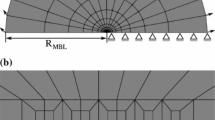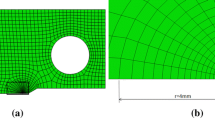Abstract
The unstable growth of a crack in a large viscoelastic plate is considered within the framework of continuum mechanics. Starting from the local stress and deformation fields at the tip of the crack, a non-linear, first order differential equation is found to describe the time history of the crack size if the stress applied far from the crack is constant. The differential equation contains the creep compliance and the intrinsic surface energy of the material. The surface energy concept for viscoelastic materials is clarified. Inertial effects are not considered, but the influence of temperature is included for thermorheologically simple materials.
Initial crack velocities are given as a function of applied load in closed form, as well as a comparison of calculated crack growth history with experiments. Above a certain high stress, crack propagation ensues at high speeds controlled by material inertia while at a lower limit infinite time is required to produce crack growth. Thus an upper and lower limit criterion of the Griffith type exists. For rate insensitive (elastic) materials the two limits coalesce and only the brittle fracture criterion of Griffith exists. The implications of these results for creep fracture in metals and inorganic glasses are examined.
Résumé
L'accroissement instable d'une fissure dans une tôle viscoélastique de grande dimension est examiné sous Tangle de la mécanique des milieux continus.
En partant des distributions locales des contraintes et des déformations à l'extrémité d'une fissure, on a trouvé une équation différentielle non linéaire et du premier ordre, qui décrit l'évolution de la dimension d'une fissure, dans le cas où une contrainte constante est appliquée à une distance suffisante de cette dernière. Dans l'équation différentielle interviennent le fluage et l'énergie intrinsèque de surface du matériau. Le concept d'énergie de surface est éclairci dans le cas des matériaux viscoélastiques. Les effets d'inertie ne sont pas pris en considération, mais l'influence de la température est étudiée pour des matériaux à rhéologie thermique simple. On exprime les vitesses initiales de fissuration en fonction de la charge appliquée, et on établit une comparaison entre la progression de la propagation de la fissure, déduite de calcul, et les résultats fournis par l'expérience.
Au delà d'un certain seuil de contrainte, la propagation de la fissure se fait à une grande vitesse qui dépend de l'inertie du matériau; sous une certaine limite inférieure, l'accroissement de la fissure ne se produit qu'après un temps infmi. Il existe dès lors un critère, du type de celui de Griffith, à limites supérieure et inférieure.
Dans le cas de matériaux insensibles à l'effet de la vitesse (matériaux élastiques) ces deux limites convergent et seul demeure le critère de rupture fragile de Griffith.
On examine ce qu'impliquent ces résultats dans les ruptures par fluage des métaux et des verres inorganiques.
Zusammenfassung
Es wird das ungehinderte Wachstum eines Risses in einer grossen viskoelastischen Platte vom Gesichtspunkt der Kontinuumsmechanik betrachtet. Unter Gebrauch der lokalen Spannungen and Verformungen an den Spitzen des Risses wird eine Differentialgleichung erster Ordnung abgeleitet, welche die Rissgrösse in Abhängigkeit von der Zeit für eine vom Riss weft entfernte, konstante Spannung gibt. Die Differentialgleichung enthält die viskoelastische Kriechdehnungsfunktion and die dem Material eigene Oberflächenenergie. Die Auffassung der Oberflächenenergie für viskoelastische Materialien ist erläutert. Massenträgkeit ist nicht in Betracht genommen, aber der Einfluss der Temperatur ist für thermorheologisch einfache Materialien eingeschlossen.
Die Anfangsgeschwindigkeiten der Rissbildung werden als Funktion der angelegten Spannung ausgedrückt, wie auch Vergleiche zwischen Berechnung and Versuchsresultaten. Über einer gewissen Spannung breitet sich der Riss so schnell aus, dass die Geschwindigkeit von der Wellenmechanik kontrolliert wird, während an einer un t eren Spannungsgrenze unendliche Zeit für Rissausbreitung benötigt ist. So bestehen zwei Kriterien des Griffith Types mit einer oberen and einer unteren Grenze. Für Materialien die keine Dämpfung aufweisen (elastische Materialien) fallen die zwei Grenzen zusammen and ergeben die Griffith Formel für den Sprödbruch. Folgerungen für den zeitbedingten Bruch in Metallen and inorganischen Gläsern werden angestellt.
Similar content being viewed by others
References
D. C. Stuart and O. L. Anderson, Dependence of Ultimate Strength of Glass Under Constant Load on Temperature, Ambient Atmosphere, and Time; J. Am. Ceramic Soc., 36, 12, 413–424.
H. H. Johnson and P. C. Paris, Sub-Critical Flaw Growth, Eng. Fract. Mech., 1 (1968) 3–45. See also: references 37 and 39 in that paper.
W. G. Knauss, The Time-Dependent Fracture of Viscoelastic Materials, Proceedings of the First International Conference on Fracture, Sendai, Japan, September 1965.
A. A. Griffith, The Theory of Rupture, Proc. 1st. International Congress of Applied Mechanics, Delft, 1924, pp. 55–63.
M. L. Williams, P. J. Blatz and R. A. Schapery, Fundamental Studies Relating to Systems Analysis of Solid Propellants, Graduate Aeronautical Laboratories, California Institute of Technology, SM 61-5, February 1961.
M. L. Williams, The Fracture of Viscoelastic Material, in Fracture of Solids, D. C. Drucker and J. J. Gilman, eds., Interscience Publishers, 1963.
F. A. McClintock, Effect of Root Radius, Stress, Crack Growth Rate on Fracture Instability, Proc. Roy. Soc., A, 285 (1965) 58–72.
F. Bueche and J. C. Halpin, Molecular Theory for the Tensile Strength of Gum Elastomers, J. Appl. Phys., 35 (1964) 36–41.
J. C. Halpin and H. W. Dolley, Observations on the Fracture of Viscoelastic Bodies, Journal of Composite Materials, 1 (1967) 1, 64–81.
G. J. Lake and P. B. Lindley, Cut Growth and Fatigue of Rubbers, II. Experiments on a Noncrystallizing Rubber. J. App. Pol. Sci., 8 (1964) 707.
W. G. Knauss, Stable and Unstable Crack Growth in Viscoelastic Media, Proceedings of the Society of Rheology, 13 (1969) 3, 291–313.
W. G. Knauss, Failure of Polymeric Continua, Graduate Aeronautical Laboratories, California Institute of Technology, SM 62-28, July 1962.
M. L. Williams, Initiation and Growth of Viscoelastic Fracture, Int. J. Fract. Mech., 1 (1965) 4, 292–310.
M. L. Williams, The Kinetic Energy Contribution to Fracture Propagation in a Linearly Viscoelastic Material, Int. J. Fract. Mech., 4 (1968) 1, 69–78.
G. R. Irwin, Analysis of Stresses and Strains Near the End of a Crack Transversing a Plate, J. App. Mech., 24, (1957) 3, 361–364.
H. K. Mueller, Stable Crack Propagation in a Viscoelastic Strip, California Institute of Technology, Pasadena, California, Ph.D. Thesis, June 1968.
H. K. Mueller and W. G. Knauss, Crack Propagation in a Viscoelastic Strip, Graduate Aeronautical Laboratories, California Institute of Technology, SM 68-14, September 1968.
G. P. Cherepanov, Crack Propagation in Continuous Media, Appl. Math. Mech., (Prikl. Mat. Mekh.), 31 (1967) 3, 476–488.
J. R. Rice, An Examination of the Fracture Mechanics Energy Balance from the Point of View of Continuum Mechanics., Proc. 1st International Conference on Fracture, Vol. 1, Sendai, Japan, 1965.
W. G. Knauss, Stress Analysis and Energy Relations of Growing Cracks. Presented at a Colloquium on the Interdisciplinary Approach to Fracture, California Institute of Technology, February 1968.
M. P. Wnuk, Criteria of Ductile Fracture Initiated by a Pressurized Penny-Shaped Crack, J. Lubrication Technology, ASME Transactions, Paper No. 67-Lub-D.
M. P. Wnuk and W. G. Knauss, Delayed Fracture in Viscoelastic Plastic Solids, Graduate Aeronautical Laboratories, California Institute of Technology, SM 68-8. To appear in Int. J. Sol. and Struct.
M. L. Williams, R. F. Landel and J. D. Ferry, The Temperature Dependence of Relaxation Mechanisms in Amorphous Polymers and Other Glassforming Liquids, J. Am. Chem. Soc., 77 (1955) 3701–3707.
R. T. Shield and A. E. Green, On Certain Methods in the Stability Theory of Continuous Systems., Arch. Rational Mech. Anal., 12 (1963) 354–360.
W. G. Knauss and H. K. Mueller, The Mechanical Characterization of Solithane 113 in the Swollen and Unswollen State, Graduate Aeronautical Laboratories, California Institute of Technology, SM 67-8, December 1967.
R. S. Rivlin and A. G. Thomas, Rupture of Rubber, I, Characteristic Energy for Tearing, J. Appl. Pol. Sci., 10 (1952) 291–318.
A. G. Thomas, Rupture of Rubber, VI, Further Experiments on the Tear Criterion, J. Appl. Pol. Sci., 3 (1960) 168–174.
T. L. Smith, Dependence of the Ultimate Properties of a G-R-S Rubber on Strain Rate and Temperature, J. Pol. Sci., 32 (1958) 99.
F. Bueche, Physical Properties of Polymers, Interscience Publishers, New York, 1962.
Author information
Authors and Affiliations
Additional information
This work was supported by the National Aeronautics and Space Administration Research Grant No. NGL-05-002-005 GALCIT 120.
Rights and permissions
About this article
Cite this article
Knauss, W.G. Delayed failure — the Griffith problem for linearly viscoelastic materials. Int J Fract 6, 7–20 (1970). https://doi.org/10.1007/BF00183655
Received:
Revised:
Issue Date:
DOI: https://doi.org/10.1007/BF00183655




